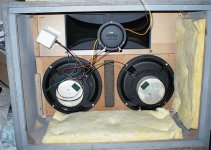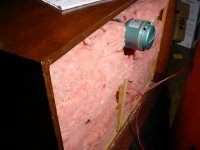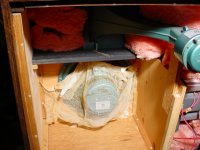1/ Not really.
2/ YMMV. The only way to find out is to try it. On the principle that adding bracing (assuming it's done sensibly) won't do any harm & might do some good, I'd add it.
3/ Yes. BAF wadding's not half bad at all.
2/ YMMV. The only way to find out is to try it. On the principle that adding bracing (assuming it's done sensibly) won't do any harm & might do some good, I'd add it.
3/ Yes. BAF wadding's not half bad at all.
1/ Not really.
2/ YMMV. The only way to find out is to try it. On the principle that adding bracing (assuming it's done sensibly) won't do any harm & might do some good, I'd add it.
3/ Yes. BAF wadding's not half bad at all.
Scott - correct me if I'm wrong, but with the general class of MLTLs , can the aspect ratio of the internal CSA be varied within reason, or the shape altered to non orthogonal, as long as the length and port venting details are maintained, without deleterious affect on performance?
For my next build for Suse, I was considering something like a trapezoid.
1/ no
2/ maybe
3/ the primary damping for microTowers is fiberglass (or ultratouch) wall insulation. Polyflll should do the job as well.
dave
2/ maybe
3/ the primary damping for microTowers is fiberglass (or ultratouch) wall insulation. Polyflll should do the job as well.
dave
I really like fiberglass as damping. It does a fantastic job absorbing high frequencies and eliminating "boxiness" while not being too restrictive of the lower octaves.
It would seem to be much more difficult/critical to achieve a perfect density of polyfill for the same effect as fiberglass lining.
I might pull (most of) the polyfill out of my Pensils and replace it with fiberglass lining just to test this theory.
It would seem to be much more difficult/critical to achieve a perfect density of polyfill for the same effect as fiberglass lining.
I might pull (most of) the polyfill out of my Pensils and replace it with fiberglass lining just to test this theory.
Although I might be nitpicking I would rather see the top and bottom in solid the same as the sides. Grain running up the sides and across the top and bottom. This avoids a grain conflict. Depending on your seasonal humidity fluctuation for a cabinet this size you could be looking at about 1/16" growth/shrinkage for the sides. If the top and bottom are plywood which does not move seasonally you will be stressing the joint where the sides meet the top and bottom.
Evan
Evan
Scott - correct me if I'm wrong, but with the general class of MLTLs , can the aspect ratio of the internal CSA be varied within reason, or the shape altered to non orthogonal, as long as the length and port venting details are maintained, without deleterious affect on performance?
For my next build for Suse, I was considering something like a trapezoid.
Right. Depending on type, it might shift the baffle step frequency a bit, ditto for edge diffraction, but in the former case, for the semi-omni types this is less of an issue / a non-issue, so within broad limits, you can adjust as you wish, while the latter is something of a separate matter.
Trapezoid is good. 🙂 I did an A10.2 box (never published) like that.
I really like fiberglass as damping. It does a fantastic job absorbing high frequencies and eliminating "boxiness" while not being too restrictive of the lower octaves.
It would seem to be much more difficult/critical to achieve a perfect density of polyfill for the same effect as fiberglass lining.
I might pull (most of) the polyfill out of my Pensils and replace it with fiberglass lining just to test this theory.
Isn't fiberglass best for lining? Not for middle of the pipe stuffing, where it will eat too much of the bass?
Isn't fiberglass best for lining? Not for middle of the pipe stuffing, where it will eat too much of the bass?
Indeed. I am actually trying to say that I think lining with fiberglass and then using very limited amounts of stuffing (or none at all) provides a sound that I prefer over jamming a cabinet full of stuffing.
Depends on the box design.
No such thing really as 'best' damping material per se, since they all have somewhat different properties / behaviours. I like 1in acoustic fiberglass myself for lining some (some) types of box.
No such thing really as 'best' damping material per se, since they all have somewhat different properties / behaviours. I like 1in acoustic fiberglass myself for lining some (some) types of box.
Not AFAIK. It can be irritating to the skin, so either get the the non-irritating type, or wear gloves when handling. No other issues that I am aware of.
http://www.diyaudio.com/forums/full...bipolar-ml-tl-chr-70-el70-14.html#post3410496
Bad for the lungs, so for vented alignments either use a vent screen or only O-C 703 or similar acoustic insulation designed for heat/AC systems [AKA duct board] as thick as required to keep from having to add stuffing except possibly at the extreme closed end where this should generally be the only internal damping fine tuning required.
For sealed, regular backless insulation is fine, though loosely fitting a cheesecloth or similar 'blanket' over the driver is required for drivers with either an open style spider and/or those with a ‘gooey’ accordion style surround to keep fiberglass dust from ruining them.
GM
Not AFAIK. It can be irritating to the skin, so either get the the non-irritating type, or wear gloves when handling. No other issues that I am aware of.
Bad for the lungs, so for vented alignments either use a vent screen or only O-C 703 or similar acoustic insulation designed for heat/AC systems [AKA duct board] as thick as required to keep from having to add stuffing except possibly at the extreme closed end where this should generally be the only internal damping fine tuning required.
For sealed, regular backless insulation is fine, though loosely fitting a cheesecloth or similar 'blanket' over the driver is required for drivers with either an open style spider and/or those with a ‘gooey’ accordion style surround to keep fiberglass dust from ruining them.
GM
Attachments
What? I've been working with fiberglass insulation off and on my whole life and never had any issue with my lungs.
Cough! Cough! 😀
But seriously, the health threat of fiberglass is extremely low. The particles are actually quite heavy, so do not remain airborne very long, and they are easily filtered by something as simple as a vacuum bag. Driving a car is far more likely to harm you.
Cough! Cough! 😀
But seriously, the health threat of fiberglass is extremely low. The particles are actually quite heavy, so do not remain airborne very long, and they are easily filtered by something as simple as a vacuum bag. Driving a car is far more likely to harm you.
I have to agree with cogitech on this. I have been using fiberglass lining in all of my speakers for years. When I open up an old speaker there usually is some loose fiberglass lying on the bottom of the cabinet. But I have never had a yellow spot on the floor under the port. The thing is that there is a net zero air flow out of a port. No net transport. No way for fiberglass fibers to escape. The longer the port, the less likely for any loose fibers to escape the cabinet.
Bob
Bob
Thanks for all the advise.
I guess damping is very much a matter of taste within the given options.
Would felt carpet underlay be a possibility for lining around the speakers?
Then there's one remark from Evanc, wich makes a lot of sense to me, to make top and
bottom from solid wood as well.
However this will rise the position of the upper speaker with about half an inch, because
of the thickness of the material. Will that have a negative effect, or won't it be audible?
Leo
I guess damping is very much a matter of taste within the given options.
Would felt carpet underlay be a possibility for lining around the speakers?
Then there's one remark from Evanc, wich makes a lot of sense to me, to make top and
bottom from solid wood as well.
However this will rise the position of the upper speaker with about half an inch, because
of the thickness of the material. Will that have a negative effect, or won't it be audible?
Leo
But seriously, the health threat of fiberglass is extremely low. The particles are actually quite heavy, so do not remain airborne very long, and they are easily filtered by something as simple as a vacuum bag.
For most folks, yes.
Yes, grill, cheese cloth, expanded knit, etc. is sufficient to keep any FG dust in, ditto when a ducted port placed somewhat above the bottom of the cab is used, but as a general caution I'll stick with mine since regular FG insulation in cabs with simple reflex vents can be a health hazard to children, pets.
GM
- Status
- Not open for further replies.
- Home
- Loudspeakers
- Full Range
- microTower bipolar ML-TL for CHR-70 or EL70


